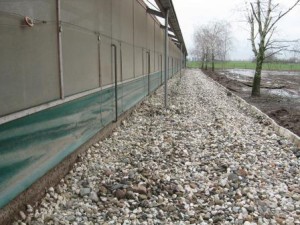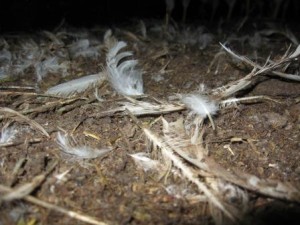This post includes the following sections:
Healthy birds
* Gut health
* Vaccinations
Disease pressure
* Litter condition
* Climate
* Bird density
* Contact with other animals
Parasites
* Red mites
* Worms
* Other parasites
Human-animal relationship
Fearfulness
Further reading
.
Healthy birds
Hens with health problems experience more stress and therefore are more prone to perform abnormal behaviours like feather pecking. Bad health can be caused by disease (e.g. Infectious Bronchitis, E.Coli infection), parasitic infection (worms, red mites) and injuries. Not only is present health status important, but also what birds have experienced earlier in life, as this may influence their resistance to health problems..
Gut health
Hens with gut health problems often start feather pecking. Providing a diet containing high fibre reduces the risk of gastro-intestinal problems and prolongs eating time. Both mechanisms help reduce the risk of feather pecking. (A tool to assess avian droppings can be found in this Henhub blog post.)
Vaccinations
Vaccinations improve bird resistance to specific diseases. Some vaccines stimulate strong reactions and thus the birds’ immune systems are placed under pressure. Such vaccines may temporarily weaken the birds, increasing the risk of feather pecking. Appropriate management can help to prevent this.
Disease pressure
Birds affected by a disease outbreak will be more susceptible to incidents of injurious pecking and often have poorer plumage condition. Disease prevention within the flock is important for many reasons. To help prevent disease outbreaks a ‘Poultry Health and Welfare Plan’ should be written in conjunction with a veterinary adviser. To be effective, the plan should be specific to the site, not a generalised document, and it should be reviewed regularly. The plan should also include regular monitoring of the health and welfare of the birds, ensuring any problems are acted upon immediately to prevent escalation.
Despite birds being exposed to uncontrollable risks in free range systems, it is still effective and important to maintain good hygiene practices. Disease prevention starts with a decent hygiene status of the whole farm:
- Aim to have a single age site to reduce disease transfer. This can also effectively eliminate Mycoplasma.
- Adopt a proactive approach to bird health, reviewing and acting on strategies in the Flock Health Plan.
- – Have dedicated clothing for each house (including boots) and use boot dips at the correct rate of dilution and keep to the manufacturer’s prescriptions for every house.
Mucking out, cleaning and disinfecting should be conducted thoroughly to prevent disease transfer from one flock to the next. Cleaning and disinfecting should be tailored to the farm to address problems that are specific to the farm.
Litter condition
Wet litter easily causes disease problems. It is therefore essential to pay ample attention to maintaining good litter quality. Maintaining good, deep, friable litter requires good housing design and maintenance. Without these, more effort is needed to achieve litter quality by daily inspection, careful management, frequent raking/forking over or rotating plus replenishing and topping up of the litter areas.
Litter around the popholes can be particularly difficult to keep dry and special attention and effort is required to keep it in good condition. Keeping the area immediately outside dry and well drained is key to keeping the litter inside the house dry. Prevent rain coming in through the popholes and have something to let the hens ‘wipe’ their feet outside, e.g. gravel. Highly-absorbent wood pellet bedding can be used where there is a problem with wet litter.
Capped (encrusted) litter often leads to feather pecking. Poor, crusted litter causes frustration which increases the birds’ need for an alternative foraging substrate. And the only alternative foraging material readily available is often the feathers of companion birds!


Climate
See our page on Climate.
Bird density
If there are many poultry farms in close vicinity to the farm, the risk of contagious diseases will increase. If the farm is located in an area with low poultry density, the risk of diseases such as Infectious Bronchitis will be lower. Health plans and vaccination schedules can be adjusted to the poultry density and the likelihood of certain infections. Because each vaccination is a challenge to bird health, consideration has to be given to the balance between the benefits and the risks of vaccination.
Contact with other animals
Access of other animals to the henhouse should be prohibited as they may be a vector of infectious diseases. This implies that all vermin (e.g. rats and mice) should be kept out as much as possible. Netting in front of ventilation openings will prohibit access to wild birds. Purposely keeping other animals, such as Llamas, on the range can be beneficial. See also section Free Range of the post Housing (subsection ‘Other animals on range’).
Parasites
Red mites
Mites, even in moderate numbers, can cause considerable stress. Effective control should include regular monitoring. Prompt and effective treatment protocols are to be devised in cooperation with the farm veterinarian (more details on poultry red mites here).
Worms
Intestinal worm infections can cause stress and are a common source of enteritis.
Monitor worm burdens throughout the flock life via post mortem examinations and faecal egg counts.
- Deworm when tests show high egg or worm counts.
- Avoid treatment via water when the birds have access to puddles, which may dilute the dosage.
- Ensure that every bird receives an effective dose (Suggestion: repeat egg counts 2 weeks after de-worming).
- Paddock rotation can help reduce the problem.
Recent evidence shows that good range management is associated with a reduced worm burden.
Other parasites
Problems with other parasites should be avoided as much as possible by taking effective biosecurity measures and maintaining a high flock health standard.
The human-animal relationship
The relationship between the caretakers and the flock is important for several reasons. Frequent contact will enable the caretaker to detect problems and take effective measures at an early stage. Frequent contact will also make the flock less fearful and therefore less prone to injurious pecking.
Flocks should be walked several times a day throughout rear and lay and attention should be paid to the behaviour of the birds. In this way any signs of injurious pecking should be spotted early enough so that it can be managed to prevent further escalation. Having a variety of people walking the birds will also increase the likelihood that potential problems are spotted before they become problems. Getting a variety of people to walk the birds will also help to get them used to different people and reduce their fearfulness. This is especially important during rear, as the chicks will eventually be exposed to different people when they are transferred to the laying house. Alternating different coloured clothes can also have the same desired effect.
 |
 |
|
|
Varying the route taken through the shed can help make the flock more robust to unexpected changes, such as a vet or field advisor walking through the shed. |
Take the time to sit or stand and observe the birds for five or ten minutes in one area. This will allow the birds the settle and resume their ‘normal’ behaviour and you will be able to spot any abnormal behaviour. Make sure to vary the areas you observe them in. |
|
 |
 |
|
|
Experience of injurious pecking can help you to spot the early signs of the behaviour. Talk to others who have had the problem and pay attention to the behaviour of the birds. |
Ideally have two people inspecting the birds together and talking as they walk around. |
Fearfulness
If birds are fearful as chicks they are more likely to develop feather pecking (FP) as adults. Lines selected for low FP responded less fearfully to an open field test, designed to test levels of fearfulness, than high FP lines. These findings indicate a relationship between fearfulness and FP, therefore it appears feasible that reducing fearfulness will reduce the risk of FP.
.
Further reading
SPECIFIC
Scientific
English
- Checklist Dermanyssus. 2008.
- Factsheet Poultry Red Mite. Mul, M., H. Bens, I. Odink-Schrijver, 2013.
Nederlands
- Parasitaire wormen bij biologische leghennen: Onderzoek naar het voorkomen van maagdarmwormen. Iepema, G., J. Wagenaar, M.W.P. Bestman. 2005.
- Hulplijst tegen vogelmijt. 2008.
- Verlagen van uitval bij leghennen. Niekerk, T.G.C.M. van; Bestman, M.W.P.; Wagenaar, J.P.; Reuvekamp, B.F.J.; Bronneberg, R.; Vriens, R.; Westerbeek, F.; Westendorp, S. 2012. Wageningen UR Livestock Research, 2012: 48.
GENERAL
English
 |
 |
|
| FeatherWel management guide [pdf, 5.49mb] | AssureWel advice guide [pdf, 661kb] |
- A guide to the practical management of feather pecking and cannibalism in free range laying hens. Defra, 2005 (html)
- Animal welfare on organic farms. Fact sheet series reducing the risk of feather pecking for laying hens in organic egg production. Produced in consultation with the ECOA Animal Welfare Task Force, February 2009
- Controlling feather pecking & cannibalism in laying hens without beak trimming. Pickett H., July 2008 Compassion in World Farming
- Controlling feather pecking & cannibalism in laying hens without beak trimming. Pickett H., October 2009. Compassion in World Farming. This report reviews the evidence from the scientific literature and from practical experience.
- Feather pecking and cannibalism on OrganicVet.Co.UK
Nederlands
 |
 |
|
| Noodmaatregelen tegen pikkerij [Treatment of FP]. Van Niekerk et al. 2013 (Report, 32 pp). | Van kuiken tot kip [Prevention of FP]. Van Niekerk et al.2011 (Report, 32 pp). |
Dansk
 |
||
| Fjerpilningsnøgle [Feather pecking key]. Johansen, N.F. 2013 (Report, 48 pp). |
- Fjerpilning og fjerpilningsnøgle, Johansen, N.F. 2013 (webpage).